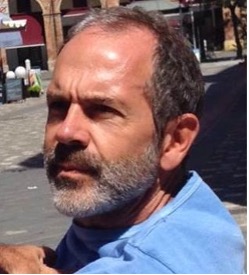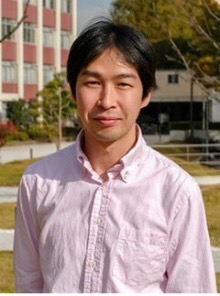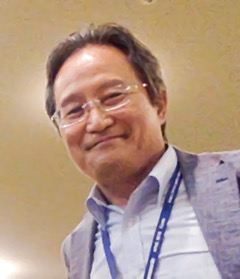WPT School
WPT School will be held on May 8, 2024.
WPT School
May 8, 09:30 – 10:30 [Room A]
1: Wireless power transmission through agile and reconfigurable radiating architectures
Lecturer: Diego Masotti (University of Bologna, Italy)
Abstract:
In wireless power transfer (WPT) applications the weakest contribution to the overall link efficiency is the effective selection of the zone to be powered. Hence, the need for smart transmitting architectures is of crucial importance. In this talk, two promising families of highly-reconfigurable arrays are presented: time-modulated arrays (TMAs) and frequency-diverse arrays (FDAs) are considered as powerful tools for selective WPT, through their peculiar radiation capabilities; the exploitation of innovative layouts allows to further improve these arrays performance thus avoiding the illumination of unwanted targets.
Biography:
 Diego Masotti (M’00, SM’16) received the Ph.D. degree in electric engineering from the University of Bologna, Italy, in 1997. In 1998 he joined the University of Bologna where he now serves as an Associate Professor of electromagnetic fields. From 2021 he has the role of coordinator of the Telecommunications Engineering Master Degree course. His research interests are in the areas of nonlinear microwave circuit simulation and design, with emphasis on nonlinear/electromagnetic co-design of integrated radiating subsystems/systems for wireless power transfer and energy harvesting applications. He authored more than 80 scientific publications on peer reviewed international journals and more than 190 scientific publications on proceedings of international conferences. Dr. Masotti serves in the Editorial Board of Electronic Letters, of the journal of Wireless Power Transfer of Maximum Academic Press, of IEEE Access, and is a member of the Paper Review Board of the main Journals of the microwave sector.
Diego Masotti (M’00, SM’16) received the Ph.D. degree in electric engineering from the University of Bologna, Italy, in 1997. In 1998 he joined the University of Bologna where he now serves as an Associate Professor of electromagnetic fields. From 2021 he has the role of coordinator of the Telecommunications Engineering Master Degree course. His research interests are in the areas of nonlinear microwave circuit simulation and design, with emphasis on nonlinear/electromagnetic co-design of integrated radiating subsystems/systems for wireless power transfer and energy harvesting applications. He authored more than 80 scientific publications on peer reviewed international journals and more than 190 scientific publications on proceedings of international conferences. Dr. Masotti serves in the Editorial Board of Electronic Letters, of the journal of Wireless Power Transfer of Maximum Academic Press, of IEEE Access, and is a member of the Paper Review Board of the main Journals of the microwave sector.
10:30-10:45
Coffee Break
May 8, 10:45 – 11:45 [Room A]
2. Comparison of Inductive and Capacitive Power Transfer as Resonant Circuit Topologies and Applications including DWPT
Lecturer: Takehiro Imura (Tokyo University of Science, Japan)
Abstract:
Magnetic coupling and electric coupling are called inductive power transfer (IPT) and capacitive power transfer(CPT). It is known that the use of compensation or resonance circuits in these two phenomena can lead to high power and high efficiency. On the other hand, since the phenomena of magnetic and electric fields are symmetrical and similar, there are areas that can be theoretically considered to be common. In this lecture, these areas will be explained from the viewpoint of theoretical equations. Representative applications of WPT will also be introduced, including dynamic wireless power transfer(DWPT).
Biography:
 Takehiro Imura received the bachelor’s degree in electrical and electronics engineering from Sophia University, Tokyo, Japan, in 2005, and the M.E. degree in electronic engineering and the D.Eng. degree in electrical engineering from The University of Tokyo, Tokyo, in 2007 and 2010, respectively. He joined the Department of Advanced Energy, Graduate School of Frontier Sciences, University of Tokyo, as a Research Associate, where since 2015, he has been a Project Lecturer. In 2019, he joined the Department of Electrical Engineering, Tokyo University of Science, as an Associate Professor. From 2022-2023, he was a Visiting Researcher at the University of Auckland in New Zealand. He is currently investigating wireless power transfer using magnetic resonant coupling and electric resonant coupling. His research interests include dynamic wireless power transfer connected to renewable energy, sensors and cancer treatment. He is the winner of the IEEJ Industry Applications Society Distinguished Transaction Paper Award in 2015, of the IEEE Power Electronics Transactions First Prize Paper Award in 2017. He is a member of the Institute of Electrical and Electronics Engineers (IEEE), the Institute of Electronics, Information and Communication Engineers (IEICE), and the Society of Automotive Engineers of Japan (JSAE). He is a chairperson of JSAE Wireless Power Transfer System Technology Committee.
Takehiro Imura received the bachelor’s degree in electrical and electronics engineering from Sophia University, Tokyo, Japan, in 2005, and the M.E. degree in electronic engineering and the D.Eng. degree in electrical engineering from The University of Tokyo, Tokyo, in 2007 and 2010, respectively. He joined the Department of Advanced Energy, Graduate School of Frontier Sciences, University of Tokyo, as a Research Associate, where since 2015, he has been a Project Lecturer. In 2019, he joined the Department of Electrical Engineering, Tokyo University of Science, as an Associate Professor. From 2022-2023, he was a Visiting Researcher at the University of Auckland in New Zealand. He is currently investigating wireless power transfer using magnetic resonant coupling and electric resonant coupling. His research interests include dynamic wireless power transfer connected to renewable energy, sensors and cancer treatment. He is the winner of the IEEJ Industry Applications Society Distinguished Transaction Paper Award in 2015, of the IEEE Power Electronics Transactions First Prize Paper Award in 2017. He is a member of the Institute of Electrical and Electronics Engineers (IEEE), the Institute of Electronics, Information and Communication Engineers (IEICE), and the Society of Automotive Engineers of Japan (JSAE). He is a chairperson of JSAE Wireless Power Transfer System Technology Committee.
11:45-13:00
Lunch
May 8, 13:00 – 14:00 [Room A]
3. Basics of WPT systems -What is the relationship of radiative and coupled WPT?-
Lecturer: Hiroshi Hirayama (Nagoya Institute of Technology, Japan)
Abstract:
This lecture is intended to provide a unified understanding of radiative and coupled WPT. At first, the WPT system is defined as “the system of power transfer by changing frequency, impedance, and transmission mode of electromagnetic energy.” After that, various kinds of WPT systems are explained in a unified manner. This enables us to provide insightful perspectives to design sophisticated WPT systems.
This lecture answers the following questions.
– How to bridge the power-electronics-based WPT and microwave-based WPT?
– How to bridge the far-field WPT and near-field WPT?
– What is the relationship between Friis’s transmission theorem and kQ theory?
– What is the difference between field-oriented theory and circuit-oriented theory?
– What is the distance property of near-field WPT
– What is the relationship between “wired” and “wireless” power transmission?
Biography:
 Hiroshi Hirayama received the B.E., M.E., and Ph.D. degrees in electrical engineering from the University of Electro-Communications, Chofu, Japan, in 1998, 2000, and 2003, respectively. Since 2003, he has been with the Nagoya Institute of Technology, where he is currently an Associate Professor. His research interests include antenna technologies, EMC/EMI, and wireless power transmission.
Hiroshi Hirayama received the B.E., M.E., and Ph.D. degrees in electrical engineering from the University of Electro-Communications, Chofu, Japan, in 1998, 2000, and 2003, respectively. Since 2003, he has been with the Nagoya Institute of Technology, where he is currently an Associate Professor. His research interests include antenna technologies, EMC/EMI, and wireless power transmission.
14:00-14:15
Coffee Break
May 8, 14:15 – 15:15 [Room A]
4. Far field WPT- Microwave circuit theory of Rectifers
Lecturer: Simon Hemour (University of Bordeaux, France)
Abstract:
From device nonlinearity to microwave engineering of the rectifier circuit, it will be seen how rectifiers operate and they can be designed and optimized toward maximum RF-to-DC conversion efficiency.
Biography:
 Simon Hemour (Senior Member, IEEE) received the B.S. degree in electrical engineering from the University of Grenoble Alpes, Grenoble, France, in 2004, and the M.S. and Ph.D. degrees in optics, optoelectronics, and microwave engineering from the Grenoble Institute of Technology, Grenoble, in 2006 and 2010, respectively.,In 2003, he was with the European Organization for Nuclear Research, Geneva, Switzerland, as a member of the Instrumentation Department, where he was involved in the ATLAS experiment on the Large Hadron Collider. From 2006 to 2007, he was a Research Assistant with the Pidstryhach Institute of Applied Problems of Mechanics and Mathematics, National Academy of Science of Ukraine, Lviv, Ukraine. In 2007, he joined the IMEP-LAHC MINATEC Laboratory, Grenoble. From 2011 to 2015, he was with the Poly-Grames Research Center, École Polytechnique de Montréal, Montreal, QC, Canada, where he contributed to the research breakthroughs in Wireless Power Transmission and RF Energy Harvesting. He joined the Université de Bordeaux, Bordeaux, France, in 2015, where he is currently an Associate Professor and he leads research in ZeroPower wireless sensors for Remote monitoring and biomedical applications. His current research interests include wireless power transfer and hybrid energy harvesting, backscattering, nonlinear and negative resistance devices, innovative radio frequency (RF) measurements, RF interferometry, low-power microwave, and millimeter-wave conversion circuits. Dr. Hemour is a member of the IEEE MTT-25 Wireless Energy Transfer and Conversion Technical Committee. He has been invited to give many invited talks and plenary speeches at various international meetings, conferences, and forums, and his pioneering work on low-power RF energy harvesting has been highly cited. He was TPC Chair for the 2018 Wireless Power Transfer Conference (WPTC), the 2023 RFID technology and application conference (RFID-TA), and of the 2024 European Microwave Conference (EuMC). He has been a the General Chair of the 2022 IEEE Wireless Power week (WPW). He has served as a Guest Editor for IEEE Transactions on Microwave Theory and Techniques, the IEEE Journal of Electromagnetics, RF and Microwaves in Medicine and Biology, and the IEEE Journal of Radio Frequency Identification.
Simon Hemour (Senior Member, IEEE) received the B.S. degree in electrical engineering from the University of Grenoble Alpes, Grenoble, France, in 2004, and the M.S. and Ph.D. degrees in optics, optoelectronics, and microwave engineering from the Grenoble Institute of Technology, Grenoble, in 2006 and 2010, respectively.,In 2003, he was with the European Organization for Nuclear Research, Geneva, Switzerland, as a member of the Instrumentation Department, where he was involved in the ATLAS experiment on the Large Hadron Collider. From 2006 to 2007, he was a Research Assistant with the Pidstryhach Institute of Applied Problems of Mechanics and Mathematics, National Academy of Science of Ukraine, Lviv, Ukraine. In 2007, he joined the IMEP-LAHC MINATEC Laboratory, Grenoble. From 2011 to 2015, he was with the Poly-Grames Research Center, École Polytechnique de Montréal, Montreal, QC, Canada, where he contributed to the research breakthroughs in Wireless Power Transmission and RF Energy Harvesting. He joined the Université de Bordeaux, Bordeaux, France, in 2015, where he is currently an Associate Professor and he leads research in ZeroPower wireless sensors for Remote monitoring and biomedical applications. His current research interests include wireless power transfer and hybrid energy harvesting, backscattering, nonlinear and negative resistance devices, innovative radio frequency (RF) measurements, RF interferometry, low-power microwave, and millimeter-wave conversion circuits. Dr. Hemour is a member of the IEEE MTT-25 Wireless Energy Transfer and Conversion Technical Committee. He has been invited to give many invited talks and plenary speeches at various international meetings, conferences, and forums, and his pioneering work on low-power RF energy harvesting has been highly cited. He was TPC Chair for the 2018 Wireless Power Transfer Conference (WPTC), the 2023 RFID technology and application conference (RFID-TA), and of the 2024 European Microwave Conference (EuMC). He has been a the General Chair of the 2022 IEEE Wireless Power week (WPW). He has served as a Guest Editor for IEEE Transactions on Microwave Theory and Techniques, the IEEE Journal of Electromagnetics, RF and Microwaves in Medicine and Biology, and the IEEE Journal of Radio Frequency Identification.
15:15-15:30
Coffee Break
May 8, 15:30 – 16:30 [Room A]
5. Power Electronics in Near Field WPT
Lecturer: Keisuke Kusaka (Nagaoka University of Technology, Japan)
Abstract:
Power converters are key components in low-frequency magnetic-field wireless power transfer (WPT) systems. In this presentation, I will introduce the fundamentals of power converters with semiconductor switching devices, covering topics such as a principle of power conversion with semiconductor switching devices, power converter topology, techniques for reducing losses through soft switching, gate drive techniques, and more. This lecture is primarily for students, engineers, and researchers with some experience and knowledge in the field of power electronics.
Biography:
 Keisuke Kusaka received his B.S. and M.S. degrees in electrical, electronics and information engineering from Nagaoka University of Technology, Niigata, Japan in 2011, 2013, respectively. From 2015 to 2016, he was with Swiss Federal Institute of Technology in Lausanne (EPFL), Switzerland as a trainee. In 2016, he received his Ph.D. degree in energy and environment science from Nagaoka University of Technology. From 2016 to 2018, he was a postdoctoral researcher with Nagaoka University of Technology, Niigata, Japan. From 2018 to 2021, he was an assistant professor with the same university. He is currently a tenure track lecturer at Nagaoka University of Technology.
Keisuke Kusaka received his B.S. and M.S. degrees in electrical, electronics and information engineering from Nagaoka University of Technology, Niigata, Japan in 2011, 2013, respectively. From 2015 to 2016, he was with Swiss Federal Institute of Technology in Lausanne (EPFL), Switzerland as a trainee. In 2016, he received his Ph.D. degree in energy and environment science from Nagaoka University of Technology. From 2016 to 2018, he was a postdoctoral researcher with Nagaoka University of Technology, Niigata, Japan. From 2018 to 2021, he was an assistant professor with the same university. He is currently a tenure track lecturer at Nagaoka University of Technology.
16:30-16:45
Coffee Break
May 8, 16:45 – 17:45 [Room A]
6. Does Resonance Rule the Power Transfer?
Lecturer: Takashi Ohira (Toyohashi University of Technology, Japan)
Abstract:
People in the 20th century believed that the power transfer is ruled by the coupling coefficient between transmit and receive coils. This common sense was altered by an MIT research team in 2007. Their paper is entitled “strongly coupled magnetic resonance”. To correctly express their experimental success, the title should be changed to “weakly coupled”. This is because it works quite well even though the coils are located far from each other, i.e., the coupling coefficient is low. One may then think that the weak coupling is effectively compensated by strong resonance. Is it true or not? This special lecture will answer that basic question. The audience will learn what exactly dominates the power transfer performance.
Biography:
 Takashi Ohira received his PhD degree from Osaka University in 1983. He developed GaAs MMICs for multi-beam satellite transponders at NTT Yokosuka Laboratory. He created electronically steerable parasitic array radiator (ESPAR) antennas at ATR Wave Engineering Laboratories. He founded two regional chapters for IEEE MTT Society (Kansai Chapter in 2006 and Nagoya Chapter in 2010). He served as an IEEE Distinguished Lecturer from 2013 to 2015. He inaugurated the IEICE wireless power transfer annual competition championship series in 2014. He presided over IEICE Tokai Section in 2016. He is currently a Professor Emeritus at Toyohashi University of Technology. He is an IEICE Fellow, URSI Fellow, and IEEE Life Fellow.
Takashi Ohira received his PhD degree from Osaka University in 1983. He developed GaAs MMICs for multi-beam satellite transponders at NTT Yokosuka Laboratory. He created electronically steerable parasitic array radiator (ESPAR) antennas at ATR Wave Engineering Laboratories. He founded two regional chapters for IEEE MTT Society (Kansai Chapter in 2006 and Nagoya Chapter in 2010). He served as an IEEE Distinguished Lecturer from 2013 to 2015. He inaugurated the IEICE wireless power transfer annual competition championship series in 2014. He presided over IEICE Tokai Section in 2016. He is currently a Professor Emeritus at Toyohashi University of Technology. He is an IEICE Fellow, URSI Fellow, and IEEE Life Fellow.
